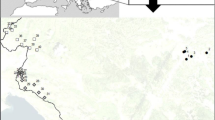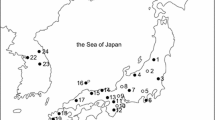Abstract
Nearly all of the known populations of Scarce Fritillary, Euphydryas maturna (Linnaeus, 1758), are declining in Western and Central Europe. In order to identify the possible reasons for its vulnerability we surveyed the population genetics of this butterfly species using multi-locus genotype data. Females of our target species lay lots of eggs in one or two batches only and pre-hibernation caterpillars live and feed gregariously in a nest. As a consequence, a random unfavourable event can eliminate most offspring of a particular female resulting in a strong genetic drift effect combined with inbreeding. Thus, our hypothesis regarding the genetic composition of Scarce Fritillary populations suggests that: (1) there will be random fluctuations in allele frequencies from generation to generation; (2) populations should exhibit small effective sizes and a relatively high level of heterozygote deficiency, and; (3) the majority of the individuals in a population will be composed of the offspring of just a few females. In order to test these hypotheses, fine-scale genetic structure was studied in two subpopulations of a Hungarian Scarce Fritillary population for 4 consecutive years (generations) using enzyme polymorphism data. The results supported all of our assumptions. We detected random fluctuation in the frequency of several alleles, small effective population size and the index of heterozygote deficiency (F IS) indicated a considerable level of inbreeding in most samples. Furthermore, average values of relatedness were also fairly high, and we were able to identify 17 putative sib families in total with the two subpopulations based on estimation of individual gametic phases. Thus, the present study suggests that intrinsic factors (e.g. specific life history) might increase the sensitivity of a species to various threatening factors (e.g. habitat loss or fragmentation) and result in the vulnerability of the given species.


Similar content being viewed by others
References
Awad M, Laugier, G. J. M., Loiseau A, Nedvěd O (2015) Unbalanced polyandry in wild-caught ladybirds Harmonia axyridis (Coleoptera: Coccinellidae). Appl Entomol Zool 50(4):427–434. doi:10.1007/s13355-015-0348-5
Bentzen P, Olsen JB, McLean JE, Seamons TR, Quinn TP (2001) Kinship analysis of Pacific Salmon: insights into mating, homing, and timing of reproduction. J Hered 92(2):127–136. doi:10.1093/jhered/92.2.127
Bereczki J, Pecsenye K, Peregovits L, Varga Z (2005) Pattern of genetic differentiation in the Maculinea alcon species group (Lepidoptera, Lycaenidae) in Central Europe. J Zool Syst Evol Res 43(2):157–165. doi:10.1111/j.1439-0469.2005.00305.x
Blouin MS (2003) DNA-based methods for pedigree reconstruction and kinship analysis in natural populations. Trends Ecol Evol 18(10):503–511. doi:10.1016/S0169-5347(03)00225-8
Bos DH, Turner SM, Andrew DeWoody J (2007) Haplotype inference from diploid sequence data: evaluating performance using non-neutral MHC sequences. Hereditas 144(6):228–234. doi:10.1111/j.2007.0018-0661.01994.x
Cizek O, Konvicka M (2005) What is a patch in a dynamic metapopulation? Mobility of an endangered woodland butterfly, Euphydryas maturna. Ecography 28:1–10. doi:10.1111/j.2005.0906-7590.04268.x
Do C, Waples RS, Peel D, Macbeth GM, Tillett BJ, Ovenden JR (2014) NeEstimator v2: re-implementation of software for the estimation of contemporary effective population size (Ne) from genetic data. Mol Ecol Resour 14(1):209–214. doi:10.1111/1755-0998.12157
Dolek M, Freese-Hager A, Cizek O, Gros P (2007) Mortality of early instars in the highly endangered butterfly Euphydryas maturna (Linnaeus, 1758) (Nymphalidae). Nota Lepidopterol 29(3/4):221–224
Dolek M, Freese-Hager A, Geyer A, Balletto E, Bonelli S (2012) Multiple oviposition and larval feeding strategies in Euphydryas maturna (Linné, 1758) (Nymphalidae) at two disjoint European sites. J Insect Conserv 17(2):357–366. doi:10.1007/s10841-012-9516-x
Eliasson CU, Shaw MR (2003) Prolonged life cycles, oviposition sites, foodplants and Cotesia parasitoids of Melitaeini butterflies in Sweden. Oedippus 21:1–52
Excoffier L, Lischer, H. E. L. (2010) Arlequin suite ver 3.5: a new series of programs to perform population genetics analyses under Linux and Windows. Mol Ecol Resour 10(3):564–567. doi:10.1111/j.1755-0998.2010.02847.x
Excoffier L, Smouse PE, Quattro JM (1992) Analysis of molecular variance inferred from metric distances among DNA haplotypes: application to human mitochondrial DNA restriction data. Genetics 131(2):479–491
Excoffier L, Laval G, Balding D (2003) Gametic phase estimation over large genomic regions using an adaptive window approach. Hum Genom 1:7. doi:10.1186/1479-7364-1-1-7
Freese A, Benes J, Bolz R, Cizek O, Dolek M, Geyer A et al (2006) Habitat use of the endangered butterfly Euphydryas maturna and forestry in Central Europe. Anim Conserv 9:388–397
Goudet J (1995) FSTAT (Version 1.2): a computer program to calculate F-statistics. J Hered 86(6):485–486
Habel JC, Schmitt T (2012) The burden of genetic diversity. Biol Conserv 147(1):270–274. doi:10.1016/j.biocon.2011.11.028
Habel JC, Rödder D, Schmitt T, Nève G (2011) Global warming will affect the genetic diversity and uniqueness of Lycaena helle populations. Glob Change Biol 17(1):194–205. doi:10.1111/j.1365-2486.2010.02233.x
Inada K, Kitade O, Morino H (2011) Paternity analysis in an egg-carrying aquatic insect Appasus major (Hemiptera: Belostomatidae) using microsatellite DNA markers. Entomol Sci 14(1):43–48. doi:10.1111/j.1479-8298.2010.00420.x
Jorde PE, Ryman N (2007) Unbiased estimator for genetic drift and effective population size. Genetics 177(2):927–935. doi:10.1534/genetics.107.075481
Kalinowski ST, Wagner AP, Taper ML (2006) ML-relate: a computer program for maximum likelihood estimation of relatedness and relationship. Mol Ecol Notes 6(2):576–579. doi:10.1111/j.1471-8286.2006.01256.x
Konvicka M, Benes J, Cizek O, Kopecek F, Konvicka O, Vitaz L (2007) How too much care kills species: grassland reserves, agri-environmental schemes and extinction of Colias myrmidone (Lepidoptera: Pieridae) from its former stronghold. J Insect Conserv 12(5):519–525. doi:10.1007/s10841-007-9092-7
Konvička M, Cížek O, Filipová L, Fric Z, Beneš J, Křupka M et al (2005) For whom the bells toll: demography of the last population of the butterfly Euphydryas maturna in the Czech Republic. Biol Bratisl 60(5):551–557
Louy D, Habel JC, Ulrich W, Schmitt T (2013) Out of the Alps: the biogeography of a disjunctly distributed mountain butterfly, the Almond-Eyed Ringlet Erebia alberganus (Lepidoptera, Satyrinae). J Hered. doi:10.1093/jhered/est081
Lowe A, Harris S, Ashton P (2009). Ecological genetics: design, analysis, and application. Wiley, Hoboken
McLaughlin JF, Hellmann JJ, Boggs CL, Ehrlich PR (2002) Climate change hastens population extinctions. Proc Natl Acad Sci 99(9):6070–6074. doi:10.1073/pnas.052131199
Nei M, Tajima F (1981) Genetic drift and estimation of effective population size. Genetics 98:625–640
Neve G, Barascud B, Descimon H, Baguette M (2008) Gene flow rise with habitat fragmentation in the bog fritillary butterfly (Lepidoptera: Nymphalidae). BMC Evol Biol 8:84. doi:10.1186/1471-2148-8-84
Öckinger E, Schweiger O, Crist TO, Debinski DM, Krauss J, Kuussaari M et al (2010) Life-history traits predict species responses to habitat area and isolation: a cross-continental synthesis. Ecol Lett 13(8):969–979. doi:10.1111/j.1461-0248.2010.01487.x
Peakall R, Smouse PE (2006) genalex 6: genetic analysis in Excel. Population genetic software for teaching and research. Mol Ecol Notes 6(1):288–295. doi:10.1111/j.1471-8286.2005.01155.x
Pecsenye K, Bereczki J, Tihanyi B, Tóth A, Peregovits L, Varga Z (2007) Genetic differentiation among the Maculinea species (Lepidoptera: Lycaenidae) in eastern Central Europe. Biol J Linn Soc 91(1):11–21. doi:10.1111/j.1095-8312.2007.00781.x
Pecsenye K, Bereczki J, Juhász E, Tartally A, Varga Z (2015) Contrasting genetic structure in cuckoo and predatory Maculinea butterflies. Conserv Genet 16(4):939–954
Queller DC, Goodnight KF (1989) Estimating relatedness using genetic markers. Evol Int J Org Evol 43(2):258–275
Rákosy L, Pecsenye K, Mihali C, Tóth A, Varga Z (2012) Taxonomic review of Euphydryas maturna (Linnaeus, 1758)(Lepidoptera, Nymphalidae) with description of a new subspecies from Dobrogea (Romania) and notes on conservation biology. Acta Zool Acad Sci Hung 58(2):145–161
Sandrin L, Meunier J, Raveh S, Walser J-C, Kölliker M (2015) Multiple paternity and mating group size in the European earwig, Forficula auricularia. Ecol Entomol 40(2):159–166. doi:10.1111/een.12171
Schmitt T, Hewitt GM (2004) The genetic pattern of population threat and loss: a case study of butterflies. Mol Ecol 13(1):21–31
Schmitt T, Röber S, Seitz A (2005) Is the last glaciation the only relevant event for the present genetic population structure of the meadow brown butterfly Maniola jurtina (Lepidoptera: Nymphalidae)? Biol J Linn Soc 85(4):419–431. doi:10.1111/j.1095-8312.2005.00504.x
Schmitt T, Rákosy L, Abadjiev S, Müller P (2007) Multiple differentiation centres of a non-Mediterranean butterfly species in south-eastern Europe. J Biogeogr 34(6):939–950. doi:10.1111/j.1365-2699.2006.01684.x
Song SD, Drew R, a I, Hughes JM (2007) Multiple paternity in a natural population of a wild tobacco fly, Bactrocera cacuminata (Diptera: Tephritidae), assessed by microsatellite DNA markers. Mol Ecol 16(11):2353–2361. doi:10.1111/j.1365-294X.2007.03277.x
Thomas JA, Telfer MG, Roy DB, Preston CD, Greenwood, J. J. D., Asher J et al (2004) Comparative losses of British butterflies, birds, and plants and the global extinction crisis. Science 303(5665):1879–1881. doi:10.1126/science.1095046
van Swaay C, Warren M (1999). Red data book of European butterflies (Rhopalocera). Council of Europe
van Swaay CM, Cuttelod A, Collins S, Maes D, Munguira L, Šašić M et al. (2010). European red list of butterflies. http://library.wur.nl/WebQuery/clc/1939351. Accessed 16 Dec 2015
Vandewoestijne S, Martin T, Liegeois S, Baguette M (2004) Dispersal, landscape occupancy and population structure in the butterfly Melanargia galathea. Basic Appl Ecol 5(6):581–591. doi:10.1016/j.baae.2004.07.004
Vrabec V, Jindra Z (1998) The caterpillars of the rare butterfly Euphydryas maturna (Lepidoptera: Nymphalidae) as food for the predatory bug Picromerus bidens (Heteroptera: Pentatomidae). Entomol Probl 29(2):87–90
Vrabec V, Čížek O, Beneš J (2002) Euphydryas maturna. In: Butterflies of Czech Republic: distribution and conservation. SOM, Prague, pp 462–457
Wahlberg N (2000) Comparative descriptions of the immature stages and ecology of five Finnish melitaeine butterfly species (Lepidoptera: Nymphalidae). Entomol Fenn 11:167–174
Wahlberg N (2001) On the status of the scarce fritillary Euphydryas maturna (Lepidoptera: Nymphalidae) in Finland. Entomol Fenn 12:244–250
Waits LP, Luikart G, Taberlet P (2001) Estimating the probability of identity among genotypes in natural populations: cautions and guidelines. Mol Ecol 10(1):249–256. doi:10.1046/j.1365-294X.2001.01185.x
Weidemann, H. J. (1985). Zum Einfluß veränderter Bewirtschaftungsweisen auf bestandsbedrohte Tagfalterarten. Maivogel (Euphydryas maturna) und Storchschnabelbläuling (Eumedonia eumedon) in Franken. Berichte der naturforschenden Gesellschaft Bamberg 60:9–130
Weir BS (1996) Genetic data analysis II: methods for discrete population genetic data. Sinauer Assoc. Inc, Sunderland
Acknowledgements
The study was supported by the Hungarian research Project Grants NKFP-3 B/023/2004 and OTKA K84071. JB was supported by a János Bolyai Scholarship of the Hungarian Academy of Sciences. We thank V. Mester for help with electrophoretic work, while L. Rákosy, S. Szabó, and P. Kozma contributed to sampling at several sites. The support of the Hungarian Nature Conservation Authorities is also much appreciated.
Author information
Authors and Affiliations
Corresponding author
Electronic supplementary material
Below is the link to the electronic supplementary material.
Rights and permissions
About this article
Cite this article
Pecsenye, K., Tóth, A., Bereczki, J. et al. A possible genetic basis for vulnerability in Euphydryas maturna (Lepidoptera: Nymphalidae). Genetica 145, 151–161 (2017). https://doi.org/10.1007/s10709-017-9953-2
Received:
Accepted:
Published:
Issue Date:
DOI: https://doi.org/10.1007/s10709-017-9953-2




